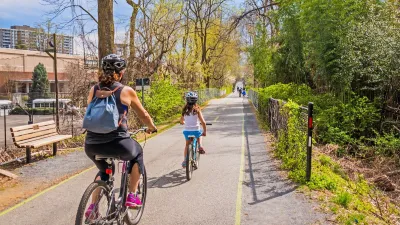The new guidelines call for pedestrian and bike infrastructure as part of the design of new state-run projects.

In an effort to prioritize pedestrians in major transportation projects, a new set of engineering guidelines from the Massachusetts Department of Transportation (MassDOT) "will require traffic engineers to include sidewalks, crosswalks, bus stops, and high-quality bike facilities when they design upgrades for the Commonwealth’s major roadways." As reported by Christian MilNeil for Streetsblog Massachusetts, the new controlling criteria call for "ADA-accessible pedestrian facilities and high-quality bikeways in state-run road reconstruction projects, plus bus shelters, crosswalks, and transit-priority infrastructure on road projects that affect major transit routes."
The policy seeks to act on MassDOT's 2013 Healthy Transportation Policy, which stated that "all MassDOT funded and or designed projects shall seek to increase and encourage more pedestrian, bicycle and transit trips." Under the new guidelines, "engineers can still request exceptions to the criteria when unusual constraints exist. But those exceptions will need to be thoroughly vetted in a public 'Design Justification Workbook,' and they’ll also need to be formally approved by the Secretary of Transportation."
MassDOT Chief Engineer Patricia Leavenworth says projects must still balance effective use of space with funding and local constraints. "It’s kind of like a household budget, where you have your list of things you want but you don’t have all the money you need, so you figure out how to compromise to get the things you really need."
FULL STORY: New ‘Controlling Criteria’ Will Require Sidewalks, Bike Lanes In State Road Projects

Alabama: Trump Terminates Settlements for Black Communities Harmed By Raw Sewage
Trump deemed the landmark civil rights agreement “illegal DEI and environmental justice policy.”

Planetizen Federal Action Tracker
A weekly monitor of how Trump’s orders and actions are impacting planners and planning in America.

The 120 Year Old Tiny Home Villages That Sheltered San Francisco’s Earthquake Refugees
More than a century ago, San Francisco mobilized to house thousands of residents displaced by the 1906 earthquake. Could their strategy offer a model for the present?

In Both Crashes and Crime, Public Transportation is Far Safer than Driving
Contrary to popular assumptions, public transportation has far lower crash and crime rates than automobile travel. For safer communities, improve and encourage transit travel.

Report: Zoning Reforms Should Complement Nashville’s Ambitious Transit Plan
Without reform, restrictive zoning codes will limit the impact of the city’s planned transit expansion and could exclude some of the residents who depend on transit the most.

Judge Orders Release of Frozen IRA, IIJA Funding
The decision is a victory for environmental groups who charged that freezing funds for critical infrastructure and disaster response programs caused “real and irreparable harm” to communities.
Urban Design for Planners 1: Software Tools
This six-course series explores essential urban design concepts using open source software and equips planners with the tools they need to participate fully in the urban design process.
Planning for Universal Design
Learn the tools for implementing Universal Design in planning regulations.
Clanton & Associates, Inc.
Jessamine County Fiscal Court
Institute for Housing and Urban Development Studies (IHS)
City of Grandview
Harvard GSD Executive Education
Toledo-Lucas County Plan Commissions
Salt Lake City
NYU Wagner Graduate School of Public Service





























